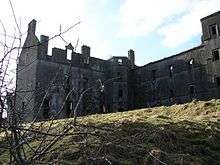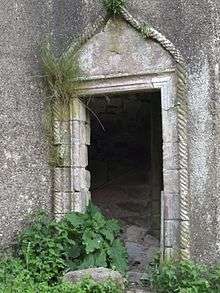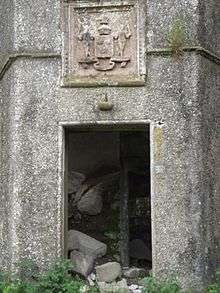Kenmure Castle

Kenmure Castle is a country house in Dumfries and Galloway, south-west Scotland. The site was occupied from the Middle Ages, and the house incorporates part of a 17th-century castle. This was remodelled in the 19th century, but the house has been derelict since the mid-20th century. It was the seat of the Gordon family of Lochinvar, later raised to the peerage as Viscounts of Kenmure. The castle is located in The Glenkens, 1 mile (1.6 km) south of the town of New Galloway. The ruin is a category B listed building and a scheduled monument.[1][2]
History
The present castle stands on a partly natural mound, which may have been modified for defence in the early Middle Ages.[2] The Lords of Galloway, rulers of a semi-independent kingdom in south-west Scotland until the 13th century, may have had a fortress here. Kenmure has been suggested as a possible birthplace in 1249 of John Balliol, later King of Scotland, whose mother Dervorguilla was daughter of Alan, the last independent Lord of Galloway.[3] It later belonged to the Douglas and Maxwell families.[4]

Kenmure became a property of the Gordon family from 1297, when they arrived from Berwickshire. The Gordons built a castle on an island in Lochinvar, some 6 miles (9.7 km) to the north.[5] An early castle which stood here was destroyed or damaged by opponents of Mary, Queen of Scots, who marched through the south-west after they defeated her supporters at the Battle of Langside (1568).[6]

Sir Robert Gordon of Lochinvar was created a baronet in 1626, and in 1633 his son Sir John Gordon was created Viscount of Kenmure by Charles I in 1633. The core of the present building is the castle which was largely erected in the 17th century, though possibly including earlier building work. The castle was laid out on the west and south sides of a courtyard, with the north and east sides formed by a high wall. The entrance gate in the north wall was flanked by towers at the two northern corners.[3] The 6th Viscount took part in the Jacobite Rising of 1715 and was subsequently beheaded and his estates forfeit. By 1790 Kenmure Castle was described as a ruin.[4]

The viscountcy was restored to Captain John Gordon in 1824, though it has been dormant since the death of his nephew, the 8th Viscount, in 1847. The castle was extensively remodelled and modernised in during the 19th century, when the courtyard wall and the north-east tower were removed with the use of gunpowder.[6] The south range was rebuilt in around 1840,[2] and in 1879 the Sheffield-based architect Matthew Ellison Hadfield was employed to remodel the west range.[7] Further extensions were made in 1908.[7] Around 1958 the building was partly demolished and the roof removed. The remains of the castle were listed in 1971, and the site was scheduled in 1998.[2]
A 17th-century sundial from Kenmure is now in Dumfries Museum.[3]
References
- ↑ "Kenmure Castle, listed building report". Historic Scotland. Retrieved 17 January 2014.
- 1 2 3 4 "Kenmure Castle, scheduled monument". Historic Scotland. Retrieved 17 January 2014.
- 1 2 3 "Kenmure Castle". Royal Commission on the Ancient and Historical Monuments of Scotland. Retrieved 17 January 2013.
- 1 2 Grose, Francis (1797). The antiquities of Scotland. pp. 189–190.
- ↑ "Lochinvar Castle". RCAHMS. Retrieved 15 January 2014.
- 1 2 MacGibbon, David; Ross, Thomas (1887). The castellated and domestic architecture of Scotland. IV. Edinburgh: David Douglas. pp. 256–260.
- 1 2 "Kenmure Castle". Dictionary of Scottish Architects. Retrieved 17 January 2014.
Coordinates: 55°03′48″N 4°08′17″W / 55.0633°N 4.138°W